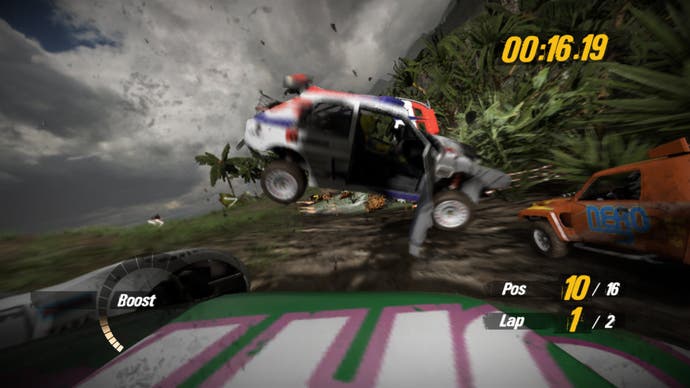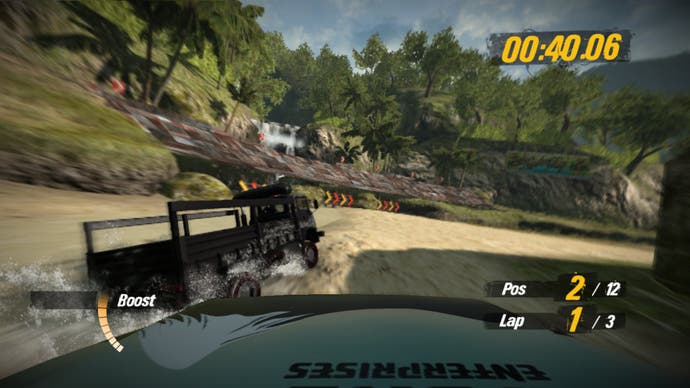The Making of PlayStation 3D
How WipEout HD and MotorStorm gained an extra dimension.
The word "immersion" comes up a lot during this presentation, but the bottom line is that Ian Bickerstaff and Simon Benson are entirely right: the 3D effect isn't just about using the tech to throw stuff in your face, it's about making gameplay feel more natural and more realistic. In our original 3D playtest, we found that was certainly the case with MotorStorm: Pacific Rift, especially with the first-person perspective.
"One interesting thing came through in the immersion aspect was that in the first-person camera view, it felt so much more like being there. Typically when most people play MotorStorm, something like 90 per cent play in the third-person view," Benson explains.
"As soon as we put the 3D settings in place, the first-person view became a lot more popular, a lot more people were using that view. This could indicate that 3D could perhaps change the standards, if you like."


In the team's tests, it also became the case that the simple, basic MotorStorm gameplay somehow felt more accessible.
"We found that in the first-person view the game is giving you all the sorts of cues that you're used to in normal driving: speed perception, the ability to judge distances, things like that. It's far easier to avoid track objects."
The insertion of true stereoscopic 3D into MotorStorm also brings about a new sense of appreciation of the scale and size of the game world and the objects within it. Benson talks about how the monster trucks aren't a particular favourite with gamers owing to the sense that they're slow and cumbersome compared to the other vehicles.
"When you're driving in 3D, if you shut one eye to recreate the 2D effect, driving along you see the ground slowly disappearing under the bonnet of your monster truck," Benson observes.
"You think, 'I could just be in a normal car here'. But when you open the other eye you see that the reason the ground is disappearing under your vehicle is because it's so far away and it all makes sense. You perceive just how big the vehicle and how fast it's actually going. It just fills in the detail for you and cues it properly."


Months before CES 2010, where the PS3 3D games got their first real debut, we produced an In Theory piece on how PlayStation 3 could own the 3D space: how television and console could combine a 2D image with the z-buffer depth map within RAM to produce a great 3D effect, albeit one with some drawbacks.
It's interesting to note that the TriOviz 3D system we looked at in the new edition of Batman: Arkham Asylum uses a similar principle. In its final form, PlayStation 3D turns out to be far more standards-compliant than we speculated (it'll work on more than just Sony's own 3D sets), but the concept we suggested looks to be a core part of the future of stereoscopic 3D on the PlayStation 3, and a cheap/fast way to ensure a 3D experience without the technical compromises.
Talking about future work for his department, Ian Bickerstaff reveals that the 2D plus depth system is being used by Sony Pictures for some of its movie projects, and that a good deal of work in implementing it on the PlayStation 3 is in progress within Sony. The ubiquitous SPUs once again reveal their magic bullet properties in overcoming a key technical challenge.
"Optimisation is a big problem with 3D images. With the movie industry they've been creating 3D films for quite a while and one of the techniques they use a lot is referred to as 'parallax from depth map' and the way this works is that you take your normal 2D image and you use the depth map as parallax look-up table to create the second eye image," explains Bickerstaff.
"At our studio we've been looking at doing this, with the left eye generated as normal and the right eye re-projected using the depth map. Basically it doesn't look too bad, it looks similar [to proper 3D]."
Ian then draws our attention to a 3D image of a spaceship in front of a mountain range. It does indeed look similar to a proper stereoscopic image, but there are some deficiencies in the image. Behind the spaceship we can see stretched textures - seemingly interpolating visual information made to fill in the gaps.
"That's there because it doesn't know what's behind the spaceship. It's basically back-filling the pixels there: large amounts of parallax create these gaps which you need to process separately," Bickerstaff says.
The problems in utilising this approach are very similar to those we saw in the TriOviz Batman effort. Effects that are not present in the depth buffer cannot be used for interpolation into a 3D image.
"Anything really subtle like transparency and reflections won't work with this approach, so what you need to do is combine it with existing 3D rendering techniques to use it properly," Bickerstaff suggests.
"Fortunately what you can do while you re-project your RGB values is that you can also re-project a new depth buffer as well and use that for your other rendering. We've been implementing it on the SPUs and found it takes around 3 per cent of total SPU time for a 1280x720 60Hz image. That isn't allowing for transfers between buffers and other things like that but it's not bad and certainly a big time-saver."
Of course, at the end of the day, whether 3D support gains traction or not will all come down to how eagerly consumers adopt the technology. Right now, 3DTVs are a niche of a niche, and the glasses factor may prove to be too much of a barrier for many, particularly when just the eye wear solus isn't exactly cheap right now (not all 3D sets come with 3D glasses).
The experience with MotorStorm: Pacific Rift and WipEout HD suggests that while 3D gaming is very much possible on retrofitted games, the image quality or frame-rate deficiencies may prove disappointing for those looking for a truly cutting edge experience. Few developers may be willing to carry out wholesale optimisations as Housemarque did to get the best possible 3D version of its Super Stardust HD, and outside of Sony developers and publishers may not be quite so motivated to supporting 3D with as much R&D muscle as the platform holder.
That being the case, the 2D plus depth option may well turn out to be the best, and cheapest way forward for games developers.
